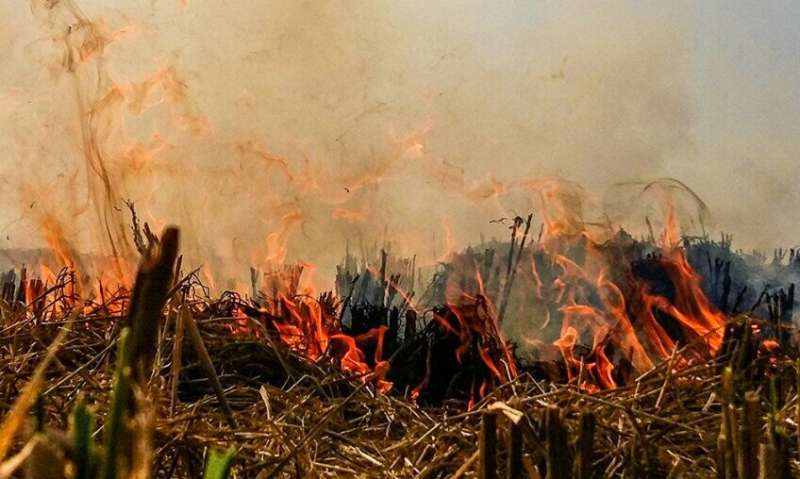Groundwater policies fire up air pollution in northwest India

A measure to conserve groundwater in northwestern India has led to unexpected consequences: Added air pollution in an area already beset by haze and smog.
A new study reveals how water-use policies require farmers to transplant rice later in the year, which in turn delays harvests and concentrates agricultural burnings of crop residues in November, a month when breezes stagnate, leading to increased air pollution.
The perfect storm of conditions during November has created almost 30% higher atmospheric concentrations of fine particulate matter, small particles that are especially concerning for human health.
The study, "Tradeoffs Between Groundwater Conservation and Air Pollution From Agricultural Fires in Northwest India," published June 17 in Nature Sustainability, is a collaboration between researchers from Cornell and the International Maize and Wheat Improvement Center (CIMMYT).
The scientists analyzed groundwater conservation policies and their effect on the timing of farmers' planting and harvesting crops and burning crop residues. They also connected this information with meteorological and air pollution data.
"This analysis shows that we need to think about sustainable agriculture from a systems perspective, because it's not a single objective we're managing for—it's multidimensional, and solving one problem in isolation can exacerbate others ," said Andrew McDonald, associate professor of soil and crop sciences and a co-author of the paper. Balwinder-Singh, a cropping systems simulation modeler at CIMMYT in New Delhi, India, is the paper's first author.
Northwest India suffers from two critical sustainability issues: air pollution and groundwater depletion. Almost 1.1 million Indians died from air pollution in 2015, adding up to costs equaling 3% of the country's gross domestic product, according to the study.
Groundwater depletion is an ongoing issue, and rice cultivation is particularly water-intensive. News reports in June shed light on water scarcity in Chennai, in the south; in the northwest, two groundwater conservation measures enacted in 2009 delayed groundwater use by farmers until later in the season. The acts ultimately prohibited transplanting rice into paddies until after June 20.
Using time-series satellite data from NASA, the researchers showed that for six rice seasons before the groundwater acts were implemented, an average of 86% of the rice-growing area in the states of Punjab and Haryana was planted on or before June 28. Less than 40% was planted on or before that date after the acts passed, according to the study.
Data showed that rice harvests then shifted later, with an aggregate eight-day harvest delay in late October and early November. This shift has led to a narrower window and a significant increase in crop residue burning in the first three weeks of November. Before the acts, the peak date for agricultural fires was Oct. 24, with 490 fires per day; it was Nov. 4, with 681 fires per day, after the acts were passed.
At the same time, meteorological data revealed that the first two weeks of November were on average cooler than the last two weeks of October, coupled with weaker winds, causing increased, stagnating air pollution in the metropolis of New Delhi, which is heavily affected by particulate matter from these agricultural fires.
Farmers must quickly clear residues immediately following rice harvests in this area, known as India's bread basket, to prepare fields for planting wheat that grows in the winter.
Solutions could include new agronomic technologies such as the tractor-mounted Happy Seeder, a device that allows farmers to drill through heavy crop residues and plant seeds without burning. They might couple such advances with shorter-duration rice varieties that offer flexibility in planting and harvesting dates.
Other options include investigating alternative uses for crop residues, such as collecting and selling biomass for power generation, bio-char creation, or as material for paper or furniture.
"There may be uses that are economically viable but they have to be considered as part of a comprehensive solution," McDonald said.
Finally, government planners are promoting agricultural development in northeastern India, which benefits from more rain and water.
More information: Balwinder-Singh et al, Tradeoffs between groundwater conservation and air pollution from agricultural fires in northwest India, Nature Sustainability (2019). DOI: 10.1038/s41893-019-0304-4
Journal information: Nature Sustainability
Provided by Cornell University




















